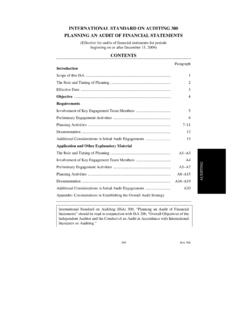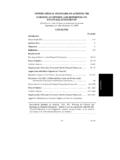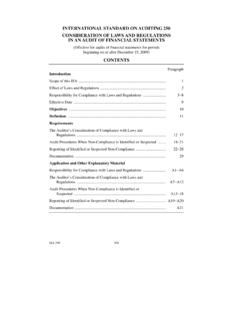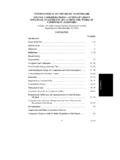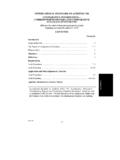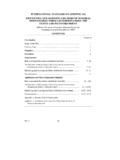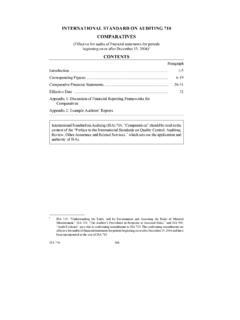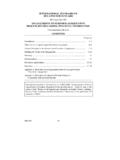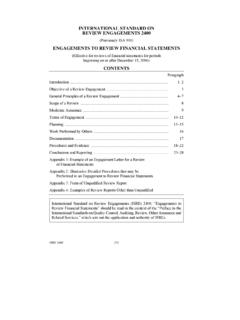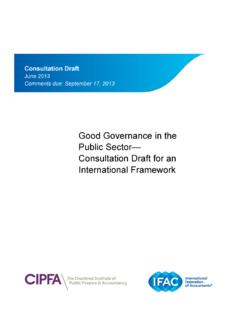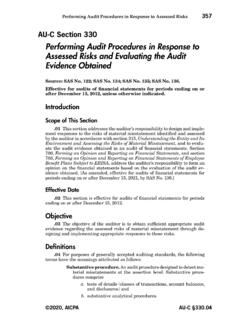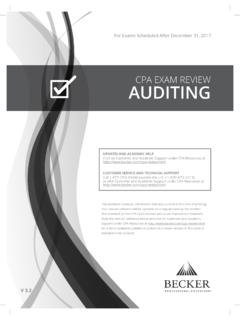Transcription of INTERNATIONAL STANDARD ON AUDITING 530 AUDIT …
1 ISA 530 465 AUDITING INTERNATIONAL STANDARD ON AUDITING 530 AUDIT SAMPLING AND OTHER MEANS OF TESTING (Effective for audits of financial statements for periods beginning on or after December 15, 2004) CONTENTS Paragraph Introduction .. 1-2 Definitions .. 3-12 AUDIT Evidence .. 13-17 Risk Considerations in Obtaining AUDIT Evidence .. 18-20 AUDIT Procedures for Obtaining AUDIT Evidence .. 21 Selecting Items for Testing to Gather AUDIT Evidence .. 22-27 Statistical versus Non-Statistical Sampling Approaches .. 28-30 Design of the Sample .. 31-39 Sample Size .. 40-41 Selecting the Sample .. 42-43 Performing the AUDIT Procedure.
2 44-46 Nature and Cause of Errors .. 47-50 Projecting Errors .. 51-53 Evaluating the Sample Results .. 54-56 Effective Date .. 57 Appendix 1: Examples of Factors Influencing Sample Size for Tests of Controls Appendix 2: Examples of Factors Influencing Sample Size for Tests of Details Appendix 3: Sample Selection Methods ISA 315, Understanding the Entity and Its Environment and Assessing the Risks of Material Misstatement, ISA 330, The Auditor s Procedures in Response to Assessed Risks, and ISA 500, AUDIT Evidence gave rise to conforming amendments to ISA 530.
3 The conforming amendments are effective for audits of financial statements for periods beginning on or after December 15, 2004 and have been incorporated in the text of ISA 530. AUDIT SAMPLING AND OTHER MEANS OF TESTING ISA 530 466 INTERNATIONAL STANDARD on AUDITING (ISA) 530, AUDIT Sampling and Other Means of Testing should be read in the context of the Preface to the INTERNATIONAL standards on Quality Control, AUDITING , Review, Other Assurance and Related Services, which sets out the application and authority of ISAs. AUDIT SAMPLING AND OTHER MEANS OF TESTING ISA 530 467 AUDITING Introduction 1. The purpose of this INTERNATIONAL STANDARD on AUDITING (ISA) is to establish standards and provide guidance on the use of AUDIT sampling and other means of selecting items for testing when designing AUDIT procedures to gather AUDIT evidence.
4 2. When designing AUDIT procedures, the auditor should determine appropriate means for selecting items for testing so as to gather sufficient appropriate AUDIT evidence to meet the objectives of the AUDIT procedures. Definitions 3. AUDIT sampling (sampling) involves the application of AUDIT procedures to less than 100% of items within a class of transactions or account balance such that all sampling units have a chance of selection. This will enable the auditor to obtain and evaluate AUDIT evidence about some characteristic of the items selected in order to form or assist in forming a conclusion concerning the population from which the sample is drawn.
5 AUDIT sampling can use either a statistical or a non-statistical approach. 4. For purposes of this ISA, error means either control deviations, when performing tests of controls, or misstatements, when performing tests of details. Similarly, total error is used to mean either the rate of deviation or total misstatement. 5. Anomalous error means an error that arises from an isolated event that has not recurred other than on specifically identifiable occasions and is therefore not representative of errors in the population. 6. Population means the entire set of data from which a sample is selected and about which the auditor wishes to draw conclusions.
6 For example, all of the items in a class of transactions or account balance constitute a population. A population may be divided into strata, or sub-populations, with each stratum being examined separately. The term population is used to include the term stratum. 7. Sampling risk arises from the possibility that the auditor s conclusion, based on a sample may be different from the conclusion reached if the entire population were subjected to the same AUDIT procedure. There are two types of sampling risk: (a) The risk the auditor will conclude, in the case of a test of controls, that controls are more effective than they actually are, or in the case of a test of details, that a material error does not exist when in fact it does.
7 This type of risk affects AUDIT effectiveness and is more likely to lead to an inappropriate AUDIT opinion; and (b) The risk the auditor will conclude, in the case of a test of controls, that controls are less effective than they actually are, or in the case of a test AUDIT SAMPLING AND OTHER MEANS OF TESTING ISA 530 468of details, that a material error exists when in fact it does not. This type of risk affects AUDIT efficiency as it would usually lead to additional work to establish that initial conclusions were incorrect. The mathematical complements of these risks are termed confidence levels. 8. Non-sampling risk arises from factors that cause the auditor to reach an erroneous conclusion for any reason not related to the size of the sample.
8 For example, ordinarily the auditor finds it necessary to rely on AUDIT evidence that is persuasive rather than conclusive, the auditor might use inappropriate AUDIT procedures, or the auditor might misinterpret AUDIT evidence and fail to recognize an error. 9. Sampling unit means the individual items constituting a population, for example checks listed on deposit slips, credit entries on bank statements, sales invoices or debtors balances, or a monetary unit. 10. Statistical sampling means any approach to sampling that has the following characteristics: (a) Random selection of a sample; and (b) Use of probability theory to evaluate sample results, including measurement of sampling risk.
9 A sampling approach that does not have characteristics (a) and (b) is considered non-statistical sampling. 11. Stratification is the process of dividing a population into subpopulations, each of which is a group of sampling units which have similar characteristics (often monetary value). 12. Tolerable error means the maximum error in a population that the auditor is willing to accept. AUDIT Evidence 13. In accordance with ISA 500, AUDIT Evidence AUDIT evidence is obtained by performing risk assessment procedures, tests of controls and substantive procedures. The type of AUDIT procedure to be performed is important to an understanding of the application of AUDIT sampling in gathering AUDIT evidence.
10 Risk Assessment Procedures 13a. In accordance with ISA 315, Understanding the Entity and Its Environment and Assessing the Risks of Material Misstatement, the auditor performs risk assessment procedures to obtain an understanding of the entity and its environment, including its internal control. Ordinarily, risk assessment procedures do not involve the use of AUDIT sampling. However, the auditor often plans and performs tests of controls concurrently with obtaining an AUDIT SAMPLING AND OTHER MEANS OF TESTING ISA 530 469 AUDITING understanding of the design of controls and determining whether they have been implemented.
